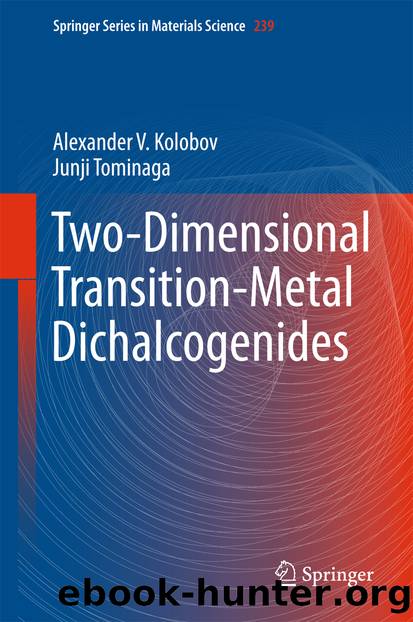Two-Dimensional Transition-Metal Dichalcogenides by Alexander V. Kolobov & Junji Tominaga

Author:Alexander V. Kolobov & Junji Tominaga
Language: eng
Format: epub
Publisher: Springer International Publishing, Cham
7.9.1.2 Wavelength Dependence
Resonance Raman scattering in single-layer measured using different excitation wavelengths [79] is shown in Fig. 7.36. Like in the bulk, despite the gap opening and a transition to a direct gap , the resonance still occurs at 633 nm (1.96 eV) and 594 nm (2.09 eV). It was proposed that the resonance is always dominated by the excitonic excitations at in both bulk and single-layer . One difference between the resonance spectra of the bulk and single-layer is the gradual lift-up of background towards high frequencies in monolayer , which was attributed to the tail of the extremely strong photoluminescence in monolayer . A significant difference between bulk and monolayer in resonance Raman spectra is that almost all the first-order and multi-phonon modes were greatly broadened and their relative intensities were substantially changed in monolayer . The sharp multi-phonon modes above 550 cm in the resonance spectra of the bulk were strongly suppressed and almost invisible in the monolayer case, in agreement with the results of [80].
Fig. 7.36Room-temperature Raman spectra of monolayer under different excitation wavelengths. The inset shows the frequency separation between the and modes, which demonstrates that the sample is monolayer [79]. Reprinted with permission. Copyright 2014 by the American Institute of Physics
Download
This site does not store any files on its server. We only index and link to content provided by other sites. Please contact the content providers to delete copyright contents if any and email us, we'll remove relevant links or contents immediately.
| Automotive | Engineering |
| Transportation |
Whiskies Galore by Ian Buxton(41718)
Introduction to Aircraft Design (Cambridge Aerospace Series) by John P. Fielding(33016)
Small Unmanned Fixed-wing Aircraft Design by Andrew J. Keane Andras Sobester James P. Scanlan & András Sóbester & James P. Scanlan(32684)
Craft Beer for the Homebrewer by Michael Agnew(18081)
Turbulence by E. J. Noyes(7893)
The Complete Stick Figure Physics Tutorials by Allen Sarah(7264)
Kaplan MCAT General Chemistry Review by Kaplan(6822)
The Thirst by Nesbo Jo(6758)
Bad Blood by John Carreyrou(6476)
Modelling of Convective Heat and Mass Transfer in Rotating Flows by Igor V. Shevchuk(6353)
Learning SQL by Alan Beaulieu(6158)
Weapons of Math Destruction by Cathy O'Neil(6084)
Man-made Catastrophes and Risk Information Concealment by Dmitry Chernov & Didier Sornette(5877)
Digital Minimalism by Cal Newport;(5586)
Life 3.0: Being Human in the Age of Artificial Intelligence by Tegmark Max(5404)
iGen by Jean M. Twenge(5322)
Secrets of Antigravity Propulsion: Tesla, UFOs, and Classified Aerospace Technology by Ph.D. Paul A. Laviolette(5237)
Design of Trajectory Optimization Approach for Space Maneuver Vehicle Skip Entry Problems by Runqi Chai & Al Savvaris & Antonios Tsourdos & Senchun Chai(4957)
Electronic Devices & Circuits by Jacob Millman & Christos C. Halkias(4865)
